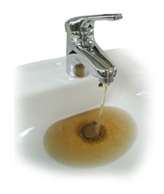Iron In Well Water Questions
Iron in well water questions are to help you realize that iron is pretty easy and inexpensive to remove normally. Here are some common questions that we are asked.

How does iron get into well water?
Iron makes up around 5% of the earth’s crust. When it rains the rain seeps through the ground and dissolves iron. The dissolved iron is then carried down into underground wells or aquifers. These aquifers are a very common source of ground water which is then used in people’s homes. The dissolved iron can be in two forms: soluble ferrous iron (Clear water iron) or the insoluble ferric iron (red water iron).
What is the difference between Ferric iron and Ferrous iron?
In simple layman terms ferrous is clear water iron. And ferric is red water iron. For example, if you put clear water iron in a water glass. It appears to be clear. Once it is exposed to oxygen, it “Oxidizes” and becomes red water iron. Which simply means it has been turned into a sediment form.
If you put red water iron in a water glass. It is usually visible as it has already been oxidized and turned into a sediment. Eventually it drops to the bottom of the glass as a sediment. You can also oxidize clear water iron with chlorine (bleach). It will turn clear water iron into red water iron. Just like oxygen does.
Why does the difference between ferric and ferrous matter?
A very common iron in well water question.
Ferrous iron is non oxidized iron, or clear water iron. Thus, it can be removed by a water softener. Of course removing iron with a water softener is usually a big mistake. Because while a water softener is able to easily clean hardness from its mineral tank. It is very hard for it to remove iron. Over time it degrades the water softener bed. And that makes the softener use more and more salt over time to try and keep the water soft. Eventually the water softener will fail. Depending of course how much iron is in the water. If it is a very small amount, usually under .3 ppm, that is not as much of a concern.
Ferric iron is red water iron. And it needs to be filtered. It will go right through a water softener. And it will collect in a water softener. Over time it will kill the water softener’s ability to function properly. So the best solution for red water iron is to be filtered by a backwashing tank. These tanks should backwash, or clean themselves, very regularly. And this keeps them from becoming iron bound. With a water softener the reverse is true.
NEVER use a water softener as a rust filter
You do not want a water softener to regenerate or clean itself unless it has become saturated. That is why a water softener should clean itself every 7 to 10 days. So that it is efficient. And that keeps you from wasting water and salt. While any iron filter should clean on a regular frequent schedule. As you can see, the two technologies don’t mix. Water softeners are to be used for hardness ONLY. While iron, sulfur and manganese filters should not be used to soften the water.
If you have both hard water and rust, for example. The iron filter should be first in line to protect the water softener from these unwanted contaminants in your well water.
Does TerminoxISM™ remove iron? Does it remove both types of iron?
TerminoxISM™ removes both forms, soluble ferrous iron (clear water iron) and insoluble ferric iron. The Terminox™ media removes the insoluble ferrous iron or clear water iron by oxidizing it immediately upon contact and then trapping it, thus pulling it out of your water. The insoluble ferric iron is removed in the same way, except it doesn’t need to be oxidized as it’s already gone through that process.
How much iron in my water is too much?
A limit for iron in your water of 0.3 mg/l of iron is where staining starts. And that is the threshold where we recommend treatment. It’s also the MCL (Maximum Contaminant Level) set by the EPA.
What are the effects of rust in my water?
Having iron in your water can cause the water to have a rusty color and can also cause reddish or orange staining on your water using appliances (bathtub, toilet, sink, etc). Sediment can also be present from iron in water. There can be a metallic taste present when drinking water that has iron in it. And iron in your water can become food for developing iron bacteria. Iron bacteria can foul filter and cause a number of issues around the home.
How can I remove iron from my water?
The most important of all questions. The TerminoxISM™ iron filter is the BEST way to remove iron from your water. Check out some TERMINOX REVIEWS from actual TerminoxISM™ customers. And for more information about this filter. Check out the links on the bottom of this page of iron in well water questions.
NEED MORE HELP?
We can help you size the right system. Including every other kind of filters or softeners that you can imagine. We can refer you to reputable water filter companies where you can buy all of our products. And where you can buy other products that we recommend Just send us an email and tell us what you are trying to do. We can even have a professional water analyst call you if you would like to email us your phone number.
Email us:
